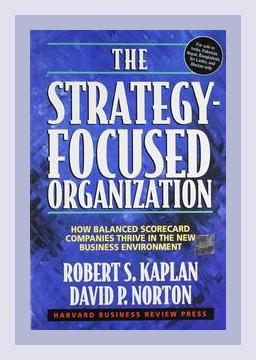Business StrategyStrategic Execution
Title: The Strategy-Focused Organization: How Balanced Scorecard Companies Thrive in the New Business Environment
Authors: Robert S. Kaplan, David P. Norton
Category: Strategic Execution
Introduction
“The Strategy-Focused Organization” by Robert S. Kaplan and David P. Norton explores the concept of the Balanced Scorecard (BSC) and its application in creating organizations focused on executing strategies effectively. The authors, building upon their earlier work, introduce a framework connecting strategic management with operational tactics through actionable insights. They present how companies can thrive in dynamic environments by transforming their strategies into tangible outcomes.
Major Themes and Concepts
1. Translating the Vision
Key Point: Translating vision into specific, measurable, and actionable strategic objectives is crucial.
Examples and Actions:
-
Example: Mobil, an early adopter of the Balanced Scorecard, clarified its vision by translating it into operational terms. They developed clear, customer-centric strategies which were disseminated throughout the organization.
-
Actionable Step: Create a detailed strategic map that aligns vision with actionable objectives. Define clear metrics for each strategic objective to measure progress.
2. Communicating and Linking
Key Point: Successful organizations ensure that everyone understands the strategy and aligns their efforts accordingly.
Examples and Actions:
-
Example: At Chemical Bank, the Balanced Scorecard was used to communicate strategic priorities across all levels. This alignment was crucial for their turnaround strategy focusing on customer satisfaction and operational efficiency.
-
Actionable Step: Develop communication plans that regularly update employees on strategic objectives. Use workshops and training sessions to ensure all levels of the organization understand and are engaged in the strategic goals.
3. Business Planning
Key Point: Integrating the Balanced Scorecard with budgeting and resource allocation processes ensures that the strategic priorities are funded and executed.
Examples and Actions:
-
Example: Cigna Property and Casualty used the Balanced Scorecard to make strategic changes and resource allocations. This integration helped redirect focus and resources to high-priority areas that aligned with their strategic goals.
-
Actionable Step: Link budgetary allocations directly with Balanced Scorecard metrics to ensure that funding follows strategic priorities. Implement a review process to adjust budget allocations based on performance against these metrics.
4. Feedback and Learning
Key Point: Continuous feedback mechanisms and organizational learning loops are essential for refining strategies and improving performance.
Examples and Actions:
-
Example: Analog Devices established a system of continuous feedback through their Balanced Scorecard. By doing so, they identified process inefficiencies and continuously improved operations.
-
Actionable Step: Set up regular intervals for reviewing balanced scorecard data and holding strategy review meetings. Ensure that there is a structured approach to incorporating learnings and making iterative improvements.
5. Aligning the Organization
Key Point: Strategic alignment across business units, support units, and employees aligns efforts towards common organizational goals.
Examples and Actions:
-
Example: Brown & Root Energy Services aligned their business units by cascading scorecards from the top level down to individual departments and projects. This allowed for coherent strategic execution across the company.
-
Actionable Step: Develop cascading scorecards for various organizational levels ensuring that each unit’s objectives align with overarching strategic goals. Regularly review and update these scorecards to maintain alignment.
Practical Implementation Framework
Five Principles of a Strategy-Focused Organization:
- Translate Strategy to Operational Terms:
- Define clear strategic objectives.
- Create strategic maps.
-
Determine key performance indicators (KPIs).
-
Align the Organization to Strategy:
- Align business units using cascading scorecards.
-
Integrate strategy into daily operational tasks and processes.
-
Make Strategy Everyone’s Job:
- Use communication strategies to inform all employees about strategic objectives.
- Develop individual scorecards and performance metrics.
-
Link incentives and rewards to strategy achievement.
-
Make Strategy a Continuous Process:
- Establish a routine of strategy review meetings.
- Utilize feedback to adjust strategies and operational tactics.
-
Promote a culture of continuous improvement and learning.
-
Mobilize Change through Executive Leadership:
- Secure strong leadership commitment to the Balanced Scorecard.
- Engage senior leaders in communicating and championing the strategy.
- Ensure leaders model the strategic behaviors and priorities they promote.
Concrete Examples and Case Studies
Mobil Oil Corporation
Actionable Steps:
– Example: Mobil broke down their strategic vision into operational terms focusing on customer satisfaction and efficiency.
– Action: Hold workshops with executive teams to translate strategic vision into detailed operational objectives and KPIs.
Chemical Bank
Actionable Steps:
– Example: Created alignment through a comprehensive internal communication strategy, further linked into performance appraisals.
– Action: Deploy regular communication campaigns and integrate strategy into employee performance review systems.
Cigna Property and Casualty
Actionable Steps:
– Example: Reallocated resources to strategic priorities. They identified critical customer satisfaction metrics and focused budgets accordingly.
– Action: Align budget planning with strategic KPIs, ensuring financial resources are allocated to the most impactful areas.
Analog Devices
Actionable Steps:
– Example: Established feedback loops that identified operational inefficiencies leading to continuous refinement of processes.
– Action: Implement regular strategy review sessions that focus on performance data and feedback to drive continuous improvement.
Brown & Root Energy Services
Actionable Steps:
– Example: Utilized cascading scorecards down to business units and project levels, ensuring cohesion in strategy implementation.
– Action: Create a cascading system of balanced scorecards ensuring each level of the organization aligns with the company-wide strategic plan.
Conclusion
“The Strategy-Focused Organization” provides a robust framework for connecting strategy with practical execution using the Balanced Scorecard. Companies are encouraged to translate high-level visions into actionable objectives, align their operations and resources with strategic goals, communicate these goals effectively across all levels, continuously engage in learning and feedback, and ensure strong leadership drives strategic change.
By following the actionable steps and examples from successful organizations, companies can harness the Balanced Scorecard to become strategy-focused, thereby thriving in a rapidly evolving business environment.
